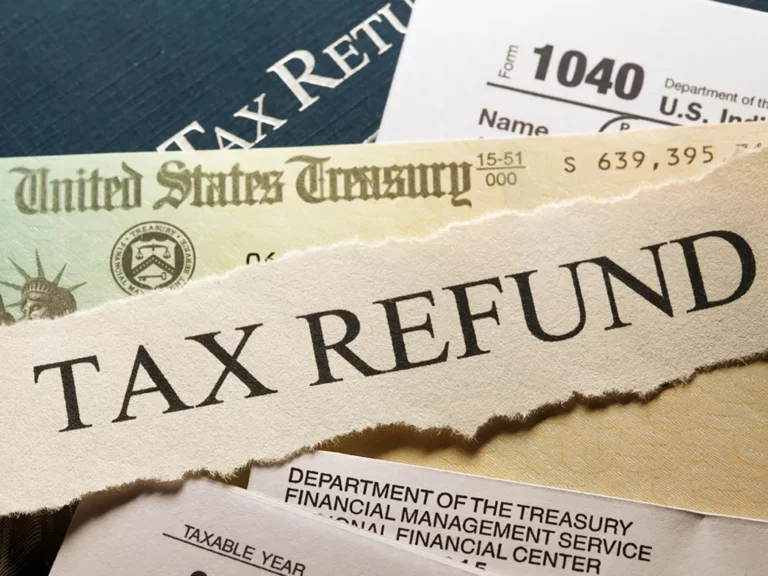On this page
What's next
Earn a high-yield savings rate with JG Wentworth Debt Relief
Leveraging Tax Refunds to Pay Off Debt
by
JG Wentworth
•
March 26, 2025
•
8 min

Tax season is no one’s favorite time of year, but it can be beneficial to your finances all the same. In particular, this time of year brings a unique opportunity for many Americans to make significant progress on their debt. With the right preparation and strategy, you can potentially increase your tax refund and use it to reduce your financial burden. Wanna know how? Let’s walk you through actionable steps to maximize your refund and apply it effectively toward debt elimination…*
Current state of credit card debt
Struggling with credit card debt? You’re far from alone. Collectively, Americans now owe a record $1.21 trillion on their credit cards, according to a new quarterly report on household debt from the Federal Reserve Bank of New York. In fact, credit card balances jumped by $45 billion in the fourth quarter of 2024, driven in part by holiday spending, and are now 7.3% higher than a year ago. At the same time, credit card delinquency rates “remained elevated,” the New York Fed researchers found — with 7.18% of balances transitioning to delinquency over the last year.
Average refunds as of 2025
For the week ending Jan. 31, 2025, the average tax refund so far this year was $1,928, but that average number is likely to change as more people file their tax returns, the IRS said. (The 2025 tax season opened on Jan. 27.) This represents a 38.2% increase from the 2024 tax year, which saw an average $1,395 in refunds per individual.
Thankfully, this trend works in your favor: the higher your return, the more you can apply it to your debt.
"*" indicates required fields
Tax refunds and debt
Since your tax refund represents money you overpaid to the government throughout the year, some financial advisors suggest adjusting your withholdings to keep more money in each paycheck. However, strategically using a larger refund for debt reduction can provide psychological and financial benefits. For those who struggle with saving incrementally, a lump-sum refund creates a perfect opportunity to make a significant impact on debt.
1. Review your filing status
Your filing status significantly impacts your tax liability. If you’re married, compare the tax implications of filing jointly versus separately. While filing jointly is often more beneficial, in certain situations (like when one spouse has significant medical expenses or income-based student loan payments), filing separately might result in a larger combined refund.
2. Claim all eligible dependents
Each qualifying dependent can reduce your taxable income through credits and deductions:
Remember that dependent relatives who meet specific criteria might also qualify, even if they don’t live with you.
3. Take advantage of education credits and deductions
If you or your dependents are pursuing education, explore:
- American Opportunity Credit (up to $2,500 per eligible student).
- Lifetime Learning Credit (up to $2,000 per tax return).
- Student loan interest deduction (up to $2,500).
4. Maximize retirement contributions
Contributing to tax-advantaged retirement accounts like Traditional IRAs can lower your taxable income for the year. You have until the tax filing deadline to make contributions for the previous tax year.
5. Claim all eligible tax credits
Tax credits directly reduce your tax liability dollar-for-dollar:
- Earned Income Tax Credit (particularly valuable for lower-income taxpayers).
- Saver’s Credit for retirement contributions.
- Energy-efficient home improvement credits.
- Health coverage tax credits.
6. Deduct eligible expenses
If you itemize deductions instead of taking the standard deduction, you might benefit from:
- Mortgage interest.
- Property taxes (subject to SALT limits).
- Charitable contributions.
- Medical expenses exceeding 7.5% of your adjusted gross income.
- Work-related expenses (if you’re self-employed).
Creating a debt reduction strategy
Some actionable steps you can take to position yourself for success:
1. Prioritize your debts
Before your refund arrives, categorize your debts based on:
- High-interest debt first (Avalanche Method) Focus on eliminating debts with the highest interest rates first (typically credit cards) to minimize the total interest paid over time.
- Smallest balance first (Snowball Method) Pay off the smallest debts completely to build momentum and motivation. While this approach might cost more in interest, the psychological benefits can help maintain your commitment to becoming debt-free.
2. Consider balance transfer options
If your refund isn’t enough to eliminate high-interest debt completely, explore transferring remaining balances to a card with a 0% introductory APR. This creates a window to pay down debt without accruing additional interest.
3. Negotiate with creditors
Before applying your refund, contact creditors to request:
- Lump-sum settlements (particularly effective with older debts).
- Interest rate reductions.
- Fee waivers.
Many creditors will offer discounts for significant lump-sum payments, stretching your refund further.
4. Create a debt payoff plan
Develop a clear allocation plan for your refund before it arrives:
- Determine exactly how much will go toward each debt.
- Decide if you’ll maintain a small emergency fund from the refund.
- Plan how you’ll adjust your monthly budget after applying the refund.
5. Set up automatic payments
After applying your refund, establish automatic payments for remaining debts to maintain momentum. Calculate how applying your refund reduces your debt timeline and set calendar reminders to celebrate these milestones.
Special considerations
Of course, no one’s financial situation is identical. A few scenarios to keep in mind:
Self-employed individuals
If you’re self-employed, focus on:
- Maximizing business deductions.
- Making estimated quarterly payments to avoid underpayment penalties.
- Setting aside a portion of your refund for future tax obligations.
Student loan debt
For federal student loans:
- Explore income-driven repayment options.
- Investigate loan forgiveness programs.
- Consider how tax deductions for student loan interest affect your overall strategy.
Homeowners with mortgage debt
Evaluate whether making an extra mortgage payment is the best use of your refund compared to targeting higher-interest debts. The mortgage interest deduction affects this calculation.
The bottom line
Your tax refund represents a powerful opportunity to accelerate your debt reduction journey. By strategically maximizing your refund and applying it thoughtfully to your highest-priority debts, you can significantly reduce your financial burden and create momentum toward financial freedom.
Remember that tax laws change frequently, so consult with a tax professional about your specific situation. The strategies outlined here should be adapted to your unique financial circumstances and goals. With careful planning, your tax refund can become a critical tool in your journey toward a debt-free future.
There’s always JG Wentworth…
If you have $10,000 or more in unsecured debt there’s a good chance you’ll qualify for the JG Wentworth Debt Relief Program.* Some of our program perks include:
- One monthly program payment
- We negotiate on your behalf
- Average debt resolution in as little as 48-60 months
- We only get paid when we settle your debt
If you think you qualify for our program, give us a call today so we can go over the best options for your specific financial needs. Why go it alone when you can have a dedicated team on your side?
SOURCES CITED
Dickler, J., “Credit card debt hit a record $1.21 trillion — here’s why ‘no one should be surprised,’ expert says.” CNBC. February 13, 2025.
About the author
Recommended reading for you
* Program length varies depending on individual situation. Programs are between 24 and 60 months in length. Clients who are able to stay with the program and get all their debt settled realize approximate savings of 43% before our 25% program fee. This is a Debt resolution program provided by JGW Debt Settlement, LLC (“JGW” of “Us”)). JGW offers this program in the following states: AL, AK, AZ, AR, CA, CO, FL, ID, IN, IA, KY, LA, MD, MA, MI, MS, MO, MT, NE, NM, NV, NY, NC, OK, PA, SD, TN, TX, UT, VA, DC, and WI. If a consumer residing in CT, GA, HI, IL, KS, ME, NH, NJ, OH, RI, SC and VT contacts Us we may connect them with a law firm that provides debt resolution services in their state. JGW is licensed/registered to provide debt resolution services in states where licensing/registration is required.
Debt resolution program results will vary by individual situation. As such, debt resolution services are not appropriate for everyone. Not all debts are eligible for enrollment. Not all individuals who enroll complete our program for various reasons, including their ability to save sufficient funds. Savings resulting from successful negotiations may result in tax consequences, please consult with a tax professional regarding these consequences. The use of the debt settlement services and the failure to make payments to creditors: (1) Will likely adversely affect your creditworthiness (credit rating/credit score) and make it harder to obtain credit; (2) May result in your being subject to collections or being sued by creditors or debt collectors; and (3) May increase the amount of money you owe due to the accrual of fees and interest by creditors or debt collectors. Failure to pay your monthly bills in a timely manner will result in increased balances and will harm your credit rating. Not all creditors will agree to reduce principal balance, and they may pursue collection, including lawsuits. JGW’s fees are calculated based on a percentage of the debt enrolled in the program. Read and understand the program agreement prior to enrollment.
This information is provided for educational and informational purposes only. Such information or materials do not constitute and are not intended to provide legal, accounting, or tax advice and should not be relied on in that respect. We suggest that you consult an attorney, accountant, and/or financial advisor to answer any financial or legal questions.






